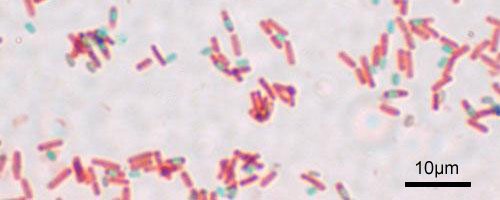
Aug. 29, 2019
Research Highlight
Surviving as an Endospore over Time

A stained preparation of cells showing endospores as green and the vegetative cell as red.Image credit: Y tambe, Wikimedia Commons.
A new study is helping astrobiologists better understand the survival strategy of microorganisms that are able to persist in adverse conditions for long periods of time as endospores. Certain microorganisms can enter a metabolically inactive state known as an endospore when conditions in the environment become harsh or even uninhabitable. In doing so, the organisms are able to wait in this state until environmental conditions improve, at which point they become active once again. This strategy could have played an important role in the evolution of life on Earth through time, allowing organisms to survive across periods of dramatic environmental change.
However, endospores are not invulnerable. The recent study looks at how aspartic acid (Asp) racemization could increase over time and ultimately kill endospores. Asp is an amino acid used in the biosynthesis of proteins. Like many molecules, Asp can exist in different orientations that are mirror images of one another. This phoenomenon is known as chirality, and the mirror image pairs are called enantiomers. The two enantiomers of a molecule are often referred to as ‘left-’ or ‘right-’ handed. Racemization is a natural process by which molecules are converted from one enantiomer to another, resulting in a mixture that is balanced between left- and right-handed forms of the molecule.
Life on Earth uses the left-handed versions of amino acids, and this ‘handedness’ is maintained in cells through biological reactions. Yet, as endospores lie dormant, racemization can occur. This can result in a loss of left-handed Asp that the cell needs when it become active again. Understanding how this process occurs in endospores, both over time and across different environmental conditions, is important in determining the long-term survivability of spore-forming bacteria in nature.
Understanding life’s survival strategies on Earth has implications in the search for life beyond our planet. This research can also inform planetary protection considerations for exploration missions that require sterilization before traveling to locations within the Solar System.
The study, “Aspartic acid racemization constrains long-term viability and longevity of endospores,” was published in the journal FEMS Microbiology Ecology. The work was supported by NASA Astrobiology through the Exobiology Program.